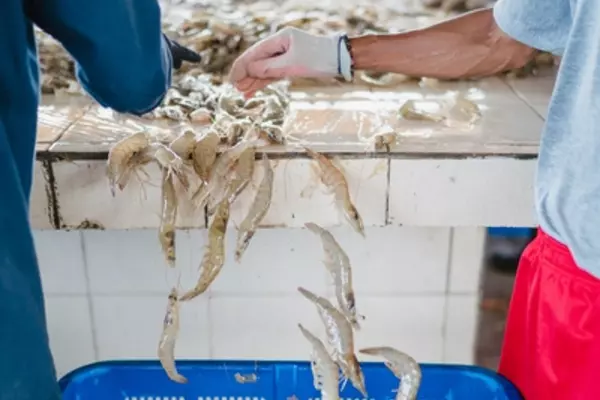Get to Know the Vannamei Shrimp as a Farmers’ Favorite
You must be familiar with vannamei shrimp, right? This shrimp from the Penaeidae family is indeed a prima donna among farmers. The reason is that when compared to other types of shrimp, vannamei has more advantages.
Shrimp with the Latin name Litopenaeus vannamei is also a type of shrimp that contributes greatly to the world of exports compared to other kinds of shrimp. No wonder more people now want to cultivate this shrimp.
Well, for those of you who are interested in knowing more about this vannamei shrimp, read this article till the end to find out the information!
Also Read: The Importance of Sterilization in Shrimp Farms
Morphology of Vannamei Shrimp

Litopenaeus vannamei has a transparent white body, making it called as white shrimp. However, its body can also gives a slightly blue color which comes from the blue chromatophores in vannamei’s body.
As an arthropod or animal that does not have a backbone, the morphology of the vannamei shrimp is divided into two parts. They are the fused head and chest (Cephalothorax) and the abdomen.
Vannamei shrimp head consists of antennae as chemoreceptors, antennae for detecting predators, mandibles, two pairs of maxillae for crushing food, maxillipeds for filtering and delivering food to the mouth, a pair of facet eyes (compound eyes), rostrum, and peripods or walking legs.
While the abdomen consists of six segments. Segments 1-3 called as tergum and segments 4-6 called as pleuron. On the abdomen of this vannamei shrimp, there are five pairs of swimming legs (pleopods) and a fan tail formed from uropods and telsons.
Also Read: Biosecurity in Shrimp Farming
Vannamei Shrimp Life Cycle
Before becoming a shrimp you often find at supermarkets, vannamei has several stages of its life cycle that must be passed. Starting from eggs, nauplius, protozoea, mysis, post-larvae, juveniles, sub-adult, to adult shrimp.
1. Egg
Female shrimp will mate with male shrimp and released up to hundred thousands eggs into the water.
2. Nauplius
The fertilized egg will then develop to the nauplius stage with a size of 0.32-0.58 mm. At this stage, vannamei shrimp do not yet have a perfect digestive system. Meanwhile, they get their food from the yolk sac.
3. Protozoea
Nauplius, which doesn’t have the yolk sacs and undergoes a molt, then turns into protozoea. At this stage, the vannamei begins to need food from the surrounding environment, such as phytoplankton.
4. Mysis
Vannamei will then undergo three moltings and turn into a mysis. The most visible development of this stage is the emergence of swimming legs (pleopods) and the addition of body segments. At the mysis stage, the size of the vannamei shrimp reaches 3.50-4.80 mm.
5. Post-larva
When it reaches the post-larva stage, the vannamei shrimp looks like an adult shrimp. At this stage, the shrimp have started to actively move straight ahead. Meanwhile, for farmers to find out the age of the post larvae, add a number behind it, for example, PL 1 for one-day-old post-larva.
6. Juvenile
The shrimp are referred to as juvenile when it reaches PL 10 or post-larva aged ten days.
7. Sub-Adult
Yuwana which is 80-90 days old, can already be called a young shrimp or sub-adult shrimp. Usually, these young shrimp have reached a weight of 21-23 grams per head.
8. Adult Shrimp
To reach the adult shrimp that are ready to be harvested, young shrimp need 25-30 days with an average weight of 28-30 grams per head.
Advantages of Vannamei Shrimp Cultivation

Since its appearance in Indonesia, vannamei shrimp has immediately become one of the potential export commodities. This is because shrimp that are originally from the sub-tropical region have excellent environmental resistance and can adapt quickly.
In addition, several other advantages include high economic value, faster growth, more resistance to disease and an unstable environment, and high viability make this shrimp become the farmers’ choice.
Also Read: Delos Technology in Shrimp Farms Capable of Harversting Over 40 Tons/Ha
Start Your Aquaculture Business with DELOS!
The advantages of vannamei shrimp are no longer in doubt. Plus, the market demand that continues to increase makes many people start to be tempted to begin cultivating this type of shrimp.
However, starting vannamei shrimp cultivation cannot be done haphazardly. There are many things to consider to get maximum yields. If you are confused about where to start vannamei shrimp cultivation, DELOS is here for you!
Through Farm Management which is integrated with the AquaHero application, DELOS can help you to explore new opportunities in the field of aquaculture through an approach to social, environmental, infrastructure, and regulatory issues at the specified location.
In addition, we also have a Supply Chain Integration program to help our partners get the best products and prices for their shrimp farming.
No need to hesitate or worry, you can directly contact DELOS at contact@delosaqua.com or submit via the contact column on our website www.delosaqua.com. Let’s start shrimp farming with DELOS!



